-
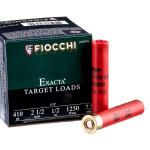 250 Rounds of .410 Ammo by Fiocchi - 1/2 ounce #7 1/2 shot
$154
250 Rounds of .410 Ammo by Fiocchi - 1/2 ounce #7 1/2 shot
$15456 Ready to Ship
-
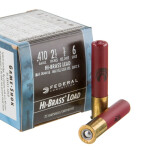 250 Rounds of .410 Ammo by Federal - #6 shot
$154
250 Rounds of .410 Ammo by Federal - #6 shot
$15410 Ready to Ship
-
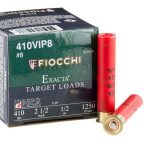 250 Rounds of .410 ammo by Fiocchi - 2-1/2" 1/2 ounce #8 Shot
$154
250 Rounds of .410 ammo by Fiocchi - 2-1/2" 1/2 ounce #8 Shot
$15450 Ready to Ship
-
 250 Rounds of 410 Bore Ammo by Fiocchi - 1/2 ounce #9 shot
$154
250 Rounds of 410 Bore Ammo by Fiocchi - 1/2 ounce #9 shot
$15420 Ready to Ship
-
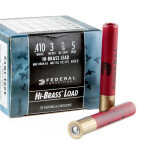 25 Rounds of .410 Ammo by Federal Game-Shok - 3" 11/16 ounce #5 shot
$16.10
25 Rounds of .410 Ammo by Federal Game-Shok - 3" 11/16 ounce #5 shot
$16.10362 Ready to Ship
-
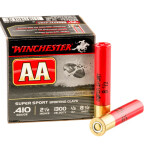 250 Rounds of .410 Ammo by Winchester AA - 1/2 ounce #8 1/2 shot
$165
250 Rounds of .410 Ammo by Winchester AA - 1/2 ounce #8 1/2 shot
$16569 Ready to Ship
-
 25 Rounds of .410 Ammo by Fiocchi - #8 shot
$16.75
25 Rounds of .410 Ammo by Fiocchi - #8 shot
$16.75134 Ready to Ship
-
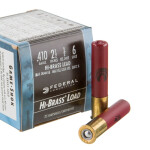 25 Rounds of .410 Ammo by Federal - #6 shot
$16.95
25 Rounds of .410 Ammo by Federal - #6 shot
$16.9573 Ready to Ship
-
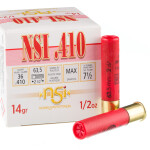 250 Rounds of .410 Ammo by NobelSport - 1/2 ounce #7 1/2 shot
$174
250 Rounds of .410 Ammo by NobelSport - 1/2 ounce #7 1/2 shot
$1748 Ready to Ship
-
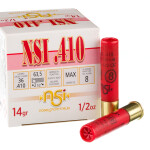 250 Rounds of .410 Ammo by NobelSport - 1/2 ounce #8 shot
$174
250 Rounds of .410 Ammo by NobelSport - 1/2 ounce #8 shot
$1741 Ready to Ship
-
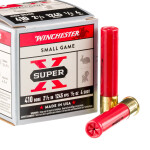 250 Rounds of .410 Ammo by Winchester Super-X - 1/2 ounce #4 shot
$174
250 Rounds of .410 Ammo by Winchester Super-X - 1/2 ounce #4 shot
$1743 Ready to Ship
-
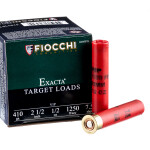 25 Rounds of .410 2-1/2" Ammo by Fiocchi - 1/2 ounce #7 1/2 shot
$17.50
25 Rounds of .410 2-1/2" Ammo by Fiocchi - 1/2 ounce #7 1/2 shot
$17.5047 Ready to Ship
-
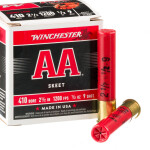 250 Rounds of .410 Ammo by Winchester AA Target - 1/2 ounce #9 shot
$189
250 Rounds of .410 Ammo by Winchester AA Target - 1/2 ounce #9 shot
$18950 Ready to Ship
-
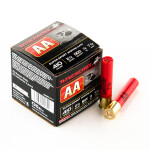 250 Rounds of .410 Ammo by Winchester AA - 1/2 ounce #7 1/2 shot
$194
250 Rounds of .410 Ammo by Winchester AA - 1/2 ounce #7 1/2 shot
$19435 Ready to Ship
-
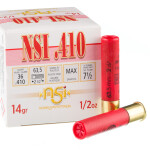 25 Rounds of .410 Ammo by NobelSport - 1/2 ounce #7 1/2 shot
$19.50
25 Rounds of .410 Ammo by NobelSport - 1/2 ounce #7 1/2 shot
$19.5068 Ready to Ship
-
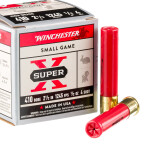 25 Rounds of .410 Ammo by Winchester - #4 shot
$19.50
25 Rounds of .410 Ammo by Winchester - #4 shot
$19.5023 Ready to Ship
-
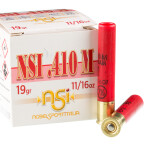 25 Rounds of .410 Ammo by NobelSport - 11/16 ounce #7 1/2 shot
$19.75
25 Rounds of .410 Ammo by NobelSport - 11/16 ounce #7 1/2 shot
$19.7575 Ready to Ship
-
 25 Rounds of .410 Ammo by Stars and Stripes - 1/2 ounce #9 shot
$19.75
25 Rounds of .410 Ammo by Stars and Stripes - 1/2 ounce #9 shot
$19.75147 Ready to Ship
-
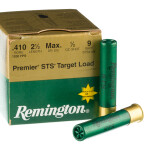 25 Rounds of .410 Ammo by Remington Premier STS - 1/2 ounce #9 shot
$19.75
25 Rounds of .410 Ammo by Remington Premier STS - 1/2 ounce #9 shot
$19.75124 Ready to Ship
-
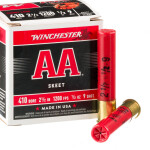 25 Rounds of .410 Ammo by Winchester AA - 1/2 ounce #9 shot
$21.50
25 Rounds of .410 Ammo by Winchester AA - 1/2 ounce #9 shot
$21.50118 Ready to Ship
-
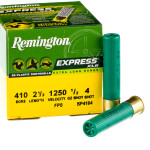 25 Rounds of .410 Ammo by Remington Express XLR - 1/2 ounce #4 shot
$23.50
25 Rounds of .410 Ammo by Remington Express XLR - 1/2 ounce #4 shot
$23.50171 Ready to Ship
-
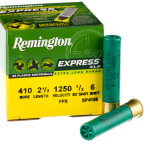 25 Rounds of .410 Ammo by Remington Express-XLR - 1/2 ounce #6 shot
$23.50
25 Rounds of .410 Ammo by Remington Express-XLR - 1/2 ounce #6 shot
$23.50165 Ready to Ship
-
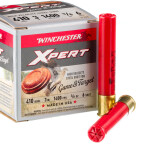 250 Rounds of .410 Ammo by Winchester Super-X - 3" 3/8 ounce #6 steel shot
$244
250 Rounds of .410 Ammo by Winchester Super-X - 3" 3/8 ounce #6 steel shot
$2447 Ready to Ship
-
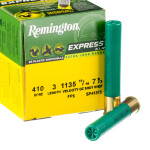 25 Rounds of .410 Ammo by Remington Express XLR - 11/16 ounce #7 1/2 shot
$25
25 Rounds of .410 Ammo by Remington Express XLR - 11/16 ounce #7 1/2 shot
$25100 Ready to Ship
-
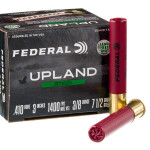 25 Rounds of .410 Ammo by Federal Upland Steel - 3/8 ounce #7 1/2 steel shot
$25.50
25 Rounds of .410 Ammo by Federal Upland Steel - 3/8 ounce #7 1/2 steel shot
$25.50269 Ready to Ship
-
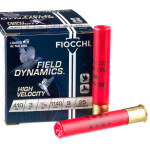 25 Rounds of .410 Ammo by Fiocchi - 11/16 ounce #9 shot
$26.25
25 Rounds of .410 Ammo by Fiocchi - 11/16 ounce #9 shot
$26.2578 Ready to Ship
-
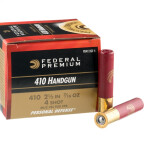 200 Rounds of .410 Ammo by Federal - #4 shot
$259
200 Rounds of .410 Ammo by Federal - #4 shot
$2594 Ready to Ship
-
 250 Rounds of .410 Ammo by Winchester Super-X - 1/4 ounce HP Rifled Slug
$349
250 Rounds of .410 Ammo by Winchester Super-X - 1/4 ounce HP Rifled Slug
$3491 Ready to Ship
-
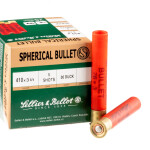 25 Rounds of .410 Ammo by Sellier & Bellot - 00 Buck
$35.50
25 Rounds of .410 Ammo by Sellier & Bellot - 00 Buck
$35.50134 Ready to Ship
-
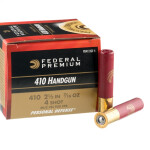 20 Rounds of .410 Ammo by Federal - #4 shot
$29
20 Rounds of .410 Ammo by Federal - #4 shot
$29131 Ready to Ship
-
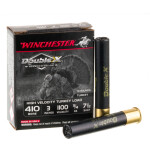 410 Bore - 3" 3/4oz. #7.5 Shot - Winchester Double X Diamond Grade - 10 Rounds
$15.75
410 Bore - 3" 3/4oz. #7.5 Shot - Winchester Double X Diamond Grade - 10 Rounds
$15.75143 Ready to Ship
-
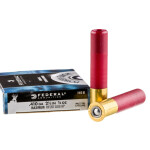 250 Rounds of .410 Ammo by Federal Power-Shok - 1/4 ounce Rifled Slug
$395
250 Rounds of .410 Ammo by Federal Power-Shok - 1/4 ounce Rifled Slug
$39526 Ready to Ship
410 Ammo - Common Uses & History
.410 bore shotshells are known for their low recoil and are often used by new shooters or, conversely, those seeking a challenge against small targets. Introduced in the 19th century by British ammo manufacturer Eley, the .410 is named for the nominal diameter of the bore firing it; despite this, it is common for shooters to refer to "410 gauge." Unlike many other shells, .410 bore ammo usually comes in hull lengths of 2-1/2" and 3". Shotguns in this gauge are typically designed for sporting use, while revolvers such as the S&W Governor and Taurus Judge can fire both .45 Colt cartridges and .410 bore shotshells and are intended as self-defense firearms. Certain survival rifles such as the M6 used by the United States Air Force also incorporated a .410 barrel.Typical uses for this gauge include target shooting and hunting; the small payload of the .410 means that it is not overly destructive to meat. Shooters usually take animals such as squirrels and rabbits with the .410 bore, as the relatively small patterns thrown by the shell are not ideal for hitting birds reliably. .410 ammo firing #6 to #9 shot is well suited to these purposes.
While most .410 loads are designed for sporting use and fire birdshot, a few fire relatively large projectiles and are intended for defensive use. Examples of these types of .410 ammo include slugs from Remington and Hornady and a 000 buck load from Federal. In this context, the .410's main advantage is the compactness of the weapon firing it, rather than the cartridge's power.
